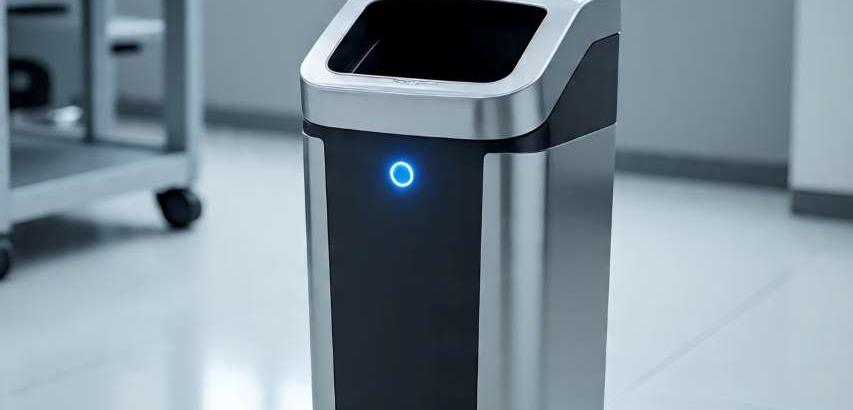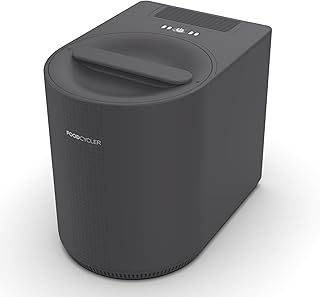
A smart trash can is an internet-connected or sensor-enabled waste bin designed to automate and improve the process of disposing of trash. It uses technology to offer features like hands-free operation, automatic bag replacement, and waste level monitoring, aiming to promote cleanliness, convenience, and efficiency in the home or office.
Key Features & Technologies
Feature/Technology | Description |
|---|---|
| Motion Sensor (Hands-Free Opening) | An infrared sensor detects motion and automatically opens the lid without touch. |
| Voice & App Control | Integration with smart assistants (Alexa, Google Assistant) and proprietary apps for commands and alerts. |
| Automatic Bag Replacement | Some premium models have a built-in system that lines a new bag after removal of the full one. |
| Odor Control System | Built-in carbon filters, UV-C lights, or deodorizer pods to neutralize smells. |
| Waste Compaction | A motorized mechanism compresses trash, allowing you to fit 2-3x more waste per bag. |
| Fullness Sensor & Alerts | Ultrasonic sensors monitor trash level and send notifications to your phone when it's full. |
| Self-Cleaning | High-end models may have a function to sanitize the inner bin using UV light. |
Types of Smart Trash Cans
| Type | Description | Best For |
|---|---|---|
| Simple Sensor Cans | Basic motion-activated opening. No connectivity. | Kitchens, bathrooms; users wanting basic hygiene. |
| Wi-Fi/Bluetooth Connected | Connects to an app for alerts, usage stats, and voice control. | Tech enthusiasts, large families. |
| Compactor Cans | Focuses on compressing waste to reduce bag changes. | Eco-conscious users, those with limited disposal space. |
| Commercial Smart Bins | Large bins with solar compacters, public Wi-Fi, and data collection for cities. | Public spaces, offices, smart cities. |
Pros vs. Cons
✅ Advantages (Pros)
- Hygienic & Touchless: Great for kitchens (raw food handling) and bathrooms; reduces germ spread.
Convenience: Opens automatically when your hands are full or dirty.
Odor Reduction: Sealed lids and filters keep unpleasant smells contained.
Efficiency: Compaction and fullness alerts mean you take the trash out only when necessary, saving bags.
Modern Aesthetic: Sleek designs (stainless steel, fingerprint-resistant coatings) elevate kitchen decor.
Data Insights: Some apps track how much you throw away, helping with waste reduction goals.
❌ Limitations (Cons)
High Cost: Significantly more expensive than traditional bins ($80 - $500+).
Power Dependency: Requires batteries or a power outlet; becomes a "dumb" can if power fails.
Complexity & Repairs: More parts (motors, sensors) mean more potential points of failure.
Proprietary Bags: Some models require specific, often expensive, branded trash bags.
Privacy Concerns: Data collection on your waste habits may be a concern for some users.
Top Use Cases & Applications
The Kitchen: The prime location for hands-free use when cooking and dealing with food waste.
The Bathroom: Keeps hygiene high by avoiding contact with potentially germy surfaces.
Home Offices: Discreetly contains trash and reduces trips to the main bin.
Households with Pets: A sealed lid prevents pets from getting into the trash.
Accessibility: Excellent for individuals with mobility issues who struggle with pedal or lid mechanisms.
Smart Home Integration: For users who want their entire home connected and automated.
How to Choose the Right One: Buying Considerations
Size & Capacity: Standard kitchen sizes are 10-16 gallons. Consider your household's waste output.
Power Source: Battery-powered (more flexible placement) vs. Plug-in (never need to change batteries). Many use D-cell batteries.
Bag Compatibility: Universal bags are a major plus. Avoid models that lock you into expensive proprietary refills.
Noise Level: Motorized compaction and lid mechanisms can be loud. Check reviews if this is a concern.
Ease of Cleaning: Removable inner buckets and dishwasher-safe parts are essential for maintenance.
Return Policy/Warranty: Given the high cost, a good warranty (1-2 years) is important.
Top Brands & Models
| Brand | Flagship Model | Known For | Price Range |
|---|---|---|---|
| simplehuman | Sensor Can Pro | Premium build quality, excellent motion sensors, wide range of sizes. | $150 - $300 |
| iTouchless | Eco | Value-focused, reliable sensor cans with good features for the price. | $80 - $150 |
| UBesGoo | Various | Budget-friendly Amazon choice with compactors. | $100 - $200 |
| TOSCANY | Automatic Open | Strong aesthetic design, often with fingerprint-proof stainless steel. | $120 - $200 |
| Nine Stars | AutoTrash | Pioneers in automatic trash compaction technology. | $250 - $500 |
Price Range
Tier | Price Range (USD) | What to Expect |
|---|---|---|
Budget | $80 - $150 | Basic motion sensor, plastic or thin stainless steel, battery-powered. |
Mid-Range | $150 - $250 | Better build quality (brushed stainless), sometimes voice control, app connectivity. |
Premium | $250 - $500+ | Compaction, automatic bag replacement, UV sanitizing, high-end materials. |
💡 Pro Tip: Place your smart trash can away from direct kitchen activity paths (like in a corner or cabinet pull-out) to prevent the sensor from triggering accidentally every time you walk by.
A smart trash can is a luxury appliance that prioritizes convenience, hygiene, and modern living. It's not a necessity, but for many, the benefits of a touch-free, odor-contained, and efficient waste system justify the investment, especially in the kitchen.
 |  |  |
 |  |  |